|
The Hornady Zombie Match
 The tradition continues with Hornady sponsoring the annual Zombie shoot in Nebraska. Defending against the un-dead is both a creative three-gun match and a really good time for competitors of all skill levels. Plus, John tests all the ways you can deliver Hornady’s .44 Magnum firepower in your choice of Smith & Wesson revolvers. Do you choose light weight in alloy for carry and absorb the recoil, or the traditional Model 29 with all steel construction. And we’re Talking Tech, defining Single Action, Double Action, and Double-Single, how they shoot and how they are carried safe. Then Julie Golob has a Pro Tip on Appendix Carry for concealment and how to do that safely. The tradition continues with Hornady sponsoring the annual Zombie shoot in Nebraska. Defending against the un-dead is both a creative three-gun match and a really good time for competitors of all skill levels. Plus, John tests all the ways you can deliver Hornady’s .44 Magnum firepower in your choice of Smith & Wesson revolvers. Do you choose light weight in alloy for carry and absorb the recoil, or the traditional Model 29 with all steel construction. And we’re Talking Tech, defining Single Action, Double Action, and Double-Single, how they shoot and how they are carried safe. Then Julie Golob has a Pro Tip on Appendix Carry for concealment and how to do that safely.
Hornady Zombie Match
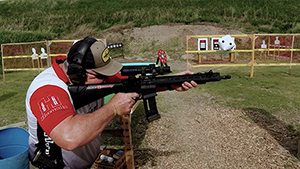 With all of the practical shooting sports, the big-ticket events need something to set them apart, especially in three-gun, where there are so many matches that it can be hard to stand out and attract competitors. But one long standing three-gun match has cracked the code on how to keep people coming back, it’s the Hornady Pandemic in the Heartland or Zombie three-gun match, and we’re in Grand Island Nebraska for the action. With all of the practical shooting sports, the big-ticket events need something to set them apart, especially in three-gun, where there are so many matches that it can be hard to stand out and attract competitors. But one long standing three-gun match has cracked the code on how to keep people coming back, it’s the Hornady Pandemic in the Heartland or Zombie three-gun match, and we’re in Grand Island Nebraska for the action.
The Hornady Pandemic in the Heartland three-gun has always stood out as one of the most interactive themed matches on the calendar. Working a multi-gun match into the confines of the bays at the host range is a labor of necessity, but making those courses of fire memorable, that is a labor of love. Just walk the bays at the Zombie three-gun, and you’ll realize right away this match isn’t like anything else. First time shooters are always welcome, with pistol, rifle, and shotgun.
More information from Hornady
History’s Guns - Broomhandle Mauser
 At the end of the 1800s firearms were rapidly evolving, with the invention of smokeless powder and the first designs of semi-auto pistols, with greater firepower than revolvers. One of the first successful designs was from Europe, that today looks very odd. The Broomhandle Mauser is now one of History’s Guns. At the end of the 1800s firearms were rapidly evolving, with the invention of smokeless powder and the first designs of semi-auto pistols, with greater firepower than revolvers. One of the first successful designs was from Europe, that today looks very odd. The Broomhandle Mauser is now one of History’s Guns.
John Tests the Smith & Wesson .44 Magnums With Hornady 240 Grain XTP
 Model 629 5 Inch Model 629 5 Inch
This is the heaviest of the three, primarily because it’s all stainless steel, the frame, the barrel, and the cylinder. This thing is heavy, just under 45 ounces empty, but in this case that’s a good thing because that weight will help offset the substantial felt recoil from the 44 magnum cartridge. Suggested Retail is $1,050.
Smith & Wesson Information
 Model 629 Performance Center Model 629 Performance Center
The 629-Performance Center is very jumpy in hand, a lot of that is due to the smaller wood grip. One positive, the double action index point on this thing is easy to find, that will lend itself to accurate shooting even with the 2.6-inch barrel. Suggested Retail $1,150.
S&W Information
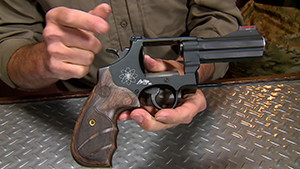 The Model 329 PD AirLight The Model 329 PD AirLight
Now to the bantam weight of this trio of heavy hitters. This is the model 329 PD AirLight, this is the big boy in the AirLight line of Revolvers. The Barrel is stainless steel, but the frame is scandium alloy, and the cylinder is Titanium alloy, and there are two grips in the box, a polymer and a wood. I should have swapped out for the polymer grip, the energy transfer with this wheel gun is just as lively as the others, especially considering it only weighs a pound and a half. Retail is $1,220 S&W Information
 Hornady 240 grain XTP Hornady 240 grain XTP
Hornady, this is Custom 44 Mag, loaded with 240 grain XTP bullets, suitable for self-defense, medium and large game. Test data from Hornady, out of a seven-and-a-half-inch barrel, shows muzzle velocities of thirteen hundred fifty feet per second and muzzle energy of 970 foot pounds.
Hornady Information
Talking Tech - Hammer Fired Hangun Actions
(Also available under Latest Updates)
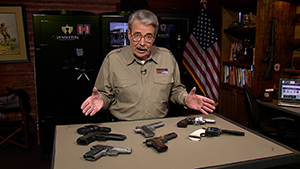 There’s a good chance a lot of you know what I’m about to explain, but with 10 million first-time gun buyers in the past two years, there’s an equally good chance a lot of you don’t. There’s a good chance a lot of you know what I’m about to explain, but with 10 million first-time gun buyers in the past two years, there’s an equally good chance a lot of you don’t.
So, today’s tech talk is on the action of hammer fired guns and every one on the table is a hammer-fired gun and each has been cleared before we start.
Colt Model P - Single Action
 So, let’s begin with the simplest, first issued in 1873, the Single Action Army, the Colt model P. This is a single-action hammer gun, meaning nothing happens until you cock the hammer. You can cock the hammer, line up a precision shot, and pull the trigger, but most of what you’ve seen with these guns involves pulling the trigger at the draw from the holster, then thumbing and releasing as fast as possible in Cowboy Fast Draw competition, or Cowboy Action Shooting. Thumb the hammer, but the trigger really isn’t involved. One other method is fanning, pulling the trigger at the draw, then sweeping the other hand across the hammer to pull it back and release it. That can be very fast. So, let’s begin with the simplest, first issued in 1873, the Single Action Army, the Colt model P. This is a single-action hammer gun, meaning nothing happens until you cock the hammer. You can cock the hammer, line up a precision shot, and pull the trigger, but most of what you’ve seen with these guns involves pulling the trigger at the draw from the holster, then thumbing and releasing as fast as possible in Cowboy Fast Draw competition, or Cowboy Action Shooting. Thumb the hammer, but the trigger really isn’t involved. One other method is fanning, pulling the trigger at the draw, then sweeping the other hand across the hammer to pull it back and release it. That can be very fast.
Colt Anaconda - Double Action
 Double Action Revolvers first became common at the start of the 20th century. Double Action means the trigger pull first rotates the cylinder to line up a fresh round, while cocking the hammer, until it’s released to strike the firing pin, that’s not part of the hammer, like the Model P. Double Action Revolvers first became common at the start of the 20th century. Double Action means the trigger pull first rotates the cylinder to line up a fresh round, while cocking the hammer, until it’s released to strike the firing pin, that’s not part of the hammer, like the Model P.
 The trigger pull also raises a transfer bar between the hammer and the firing pin in the frame, the hammer hits the bar, the bar hits the firing pin, which is a form of safety if the gun is dropped on the hammer. Now that is a lot of work for the trigger to do, and only one name comes to mind as being really fast with a double action revolver, Jerry Miculek. The trigger pull also raises a transfer bar between the hammer and the firing pin in the frame, the hammer hits the bar, the bar hits the firing pin, which is a form of safety if the gun is dropped on the hammer. Now that is a lot of work for the trigger to do, and only one name comes to mind as being really fast with a double action revolver, Jerry Miculek.
1911 - Single Action
 Now, about the same time double action revolvers were becoming popular, another single action appeared for the Military the 1911, feeding 45 ACP from a magazine. The 1911 is also hammer fired, but this hammer has to be cocked to be ready, so the 1911 got multiple safeties to prevent an accidental discharge. The thumb safety at the rear of the slide, and a grip safety that had to be depressed before the trigger could release the hammer. In the years of evolution and enhancements the grip safety grew a speed bump, to be sure it was depressed during the draw. But to be ready, the 1911 had to be chambered, with the hammer cocked behind the firing pin. Competition shooters loved it, and still do because the trigger could be very light and only had one job, releasing the hammer to fire. Now, about the same time double action revolvers were becoming popular, another single action appeared for the Military the 1911, feeding 45 ACP from a magazine. The 1911 is also hammer fired, but this hammer has to be cocked to be ready, so the 1911 got multiple safeties to prevent an accidental discharge. The thumb safety at the rear of the slide, and a grip safety that had to be depressed before the trigger could release the hammer. In the years of evolution and enhancements the grip safety grew a speed bump, to be sure it was depressed during the draw. But to be ready, the 1911 had to be chambered, with the hammer cocked behind the firing pin. Competition shooters loved it, and still do because the trigger could be very light and only had one job, releasing the hammer to fire.
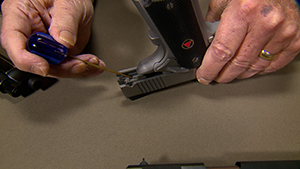 But in 1983 Colt introduced one more safety for the 1911 that gave the trigger a second job, raising the firing pin block, before the hammer could move the pin to fire. It’s a firing pin block that has to be moved up to release the pin. It’s a safety to prevent the firing pin from striking the chambered round if the gun is dropped. It’s only in the Series 80 Colt 1911s and most competitive shooters don’t like adding extra work for the trigger. So, Colt still makes the Series 70 1911s that don’t have the firing pin block. Like the custom gun makers who also leave out the firing pin block. Less work for the Trigger means you can have a better trigger with less resistance, and a crisp break to fire. But in 1983 Colt introduced one more safety for the 1911 that gave the trigger a second job, raising the firing pin block, before the hammer could move the pin to fire. It’s a firing pin block that has to be moved up to release the pin. It’s a safety to prevent the firing pin from striking the chambered round if the gun is dropped. It’s only in the Series 80 Colt 1911s and most competitive shooters don’t like adding extra work for the trigger. So, Colt still makes the Series 70 1911s that don’t have the firing pin block. Like the custom gun makers who also leave out the firing pin block. Less work for the Trigger means you can have a better trigger with less resistance, and a crisp break to fire.
Beretta Model 92 - Double - Single Action
 But now it’s 1976 and Beretta releases the model 92, and the US Army adopts it in 1985 as the M9. And the Beretta is a Double-Single Action. That means it’s carried hammer down and the first long pull of the trigger cocks the hammer and then releases it to fire. But the slide cycles and re-cocks the hammer as it loads the next round. So, the second shot and each after that has a short, light trigger pull - Single Action. The question for the Beretta, with a 15-round magazine, is how do you stop firing? How do you lower the hammer to go back to safe carry mode? Back to double action. But now it’s 1976 and Beretta releases the model 92, and the US Army adopts it in 1985 as the M9. And the Beretta is a Double-Single Action. That means it’s carried hammer down and the first long pull of the trigger cocks the hammer and then releases it to fire. But the slide cycles and re-cocks the hammer as it loads the next round. So, the second shot and each after that has a short, light trigger pull - Single Action. The question for the Beretta, with a 15-round magazine, is how do you stop firing? How do you lower the hammer to go back to safe carry mode? Back to double action.
 The answer is the de-cocker that safely drops the hammer without firing. With the Beretta, the de-cocker also applies the safety, disconnecting the trigger. Here’s one more safety in the Beretta, the firing pin block, somewhat like the Colt series 80 1911, but this one you can see operating with the trigger pull, lifting up to release the firing pin as the hammer falls. There have been a number of double-single action autoloaders with a de-cocker over the years. H-K made several models. The answer is the de-cocker that safely drops the hammer without firing. With the Beretta, the de-cocker also applies the safety, disconnecting the trigger. Here’s one more safety in the Beretta, the firing pin block, somewhat like the Colt series 80 1911, but this one you can see operating with the trigger pull, lifting up to release the firing pin as the hammer falls. There have been a number of double-single action autoloaders with a de-cocker over the years. H-K made several models.
Colt Double Eagle - Double - Single Action
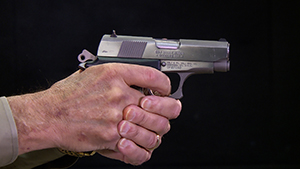 And this is the Colt Double Eagle from the 1990s, with a de-cocker that does not apply the safety, just drops the hammer. So now you know single action, double action, and double-single action hammer fired handguns. And this is the Colt Double Eagle from the 1990s, with a de-cocker that does not apply the safety, just drops the hammer. So now you know single action, double action, and double-single action hammer fired handguns.
S&W CSX - Single Action
 And the new Smith & Wesson CSX Single Acton, carried with the hammer cocked and locked by the thumb safety. And the new Smith & Wesson CSX Single Acton, carried with the hammer cocked and locked by the thumb safety.
.Pro Tip - S&W Julie Golob - Appendix Carry Done Right
 There’s been a lot of talk lately about carrying concealed in the Appendix position, in front of your body. If you choose that method, there are things you need to know. Who better to tell you those things than Smith & Wesson Pro Shooter Julie Golob. There’s been a lot of talk lately about carrying concealed in the Appendix position, in front of your body. If you choose that method, there are things you need to know. Who better to tell you those things than Smith & Wesson Pro Shooter Julie Golob.
VIEW THE PRO TIP
WEEKLY EPISODES POSTED ON THURSDAYS.
|